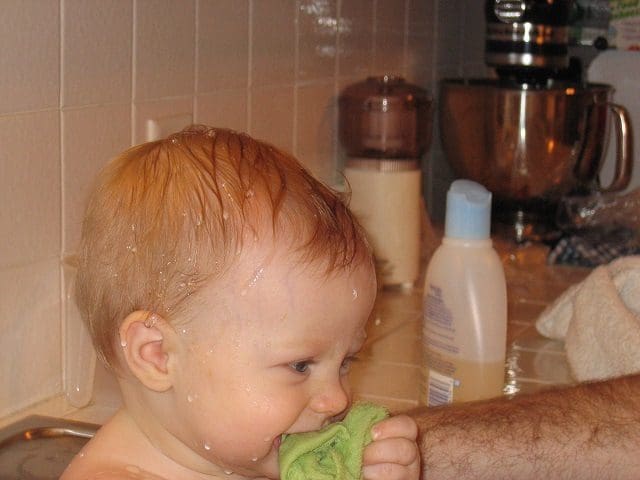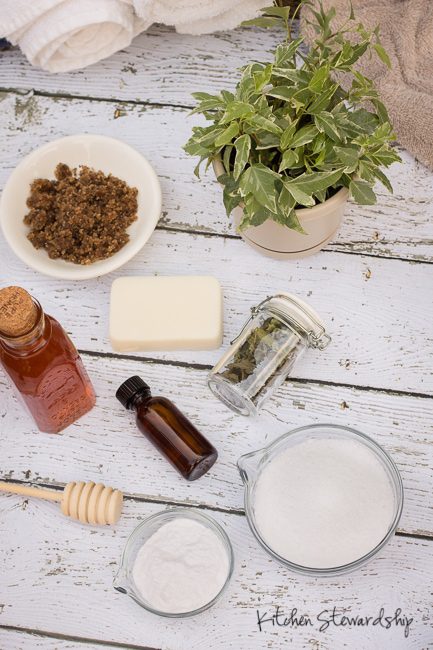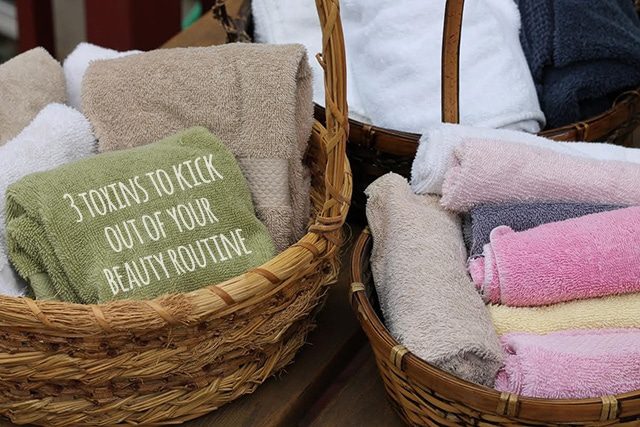The following post is from Katie of Kitchen Stewardship: 3 toxins to kick out of your beauty routine
If you were really a hippie, you wouldn’t need this post.
You know what I mean – the stereotype of the “green and crunchy” woman – no makeup, long hair, undyed and untreated, hairy armpits and legs.
Other than soap to wash her hands, that imaginary gal in the gypsy skirt and sandals doesn’t really use any personal products to speak of, so she has no worries about toxins.
But you – you might want to wear makeup sometimes. Washing your face nightly may be a non-negotiable beauty routine. And you might even want to shave your legs, at least in the summer.
Shoot, even the uber-crunchy gypsy girl probably brushes her teeth once a day, so maybe she does need to learn to read labels.
When you’re talking about finding healthy food, a lot of people recommend avoiding foods with ingredients you can’t pronounce.
Unfortunately, especially if you’re trying to baby-step your way out of the worst of the commercial personal products but don’t have the time to go DIY or the money to buy the top-of-the-line expensive “natural” brands, you’re going to have to learn to read labels. There will be plenty of words you can’t pronounce (82,000 different ingredients in personal care products), but some are worse than others. Most of the time, toxic ingredients in the products we put on our skin and in our hair may hurt us, but they’ll only potentially cause cancer or disrupt your hormones, which messes with the reproductive system. That’s all…
In the interest of baby steps today, we’ll just tackle 3 of the nastiest toxins that are often in personal care products and find out why you should kick them to the curb.
Table of Contents
1. Parabens

Parabens are a class of preservatives found in all sorts of products, from body wash to shampoo to lip balm. You name it. If it needs to last a while and is moist, you might find a paraben in there.
They’re usually under slightly longer names, like methylparaben or propylparaben, but if you see “paraben” as any part of any ingredient, get rid of it, especially if young children might use the product.
Parabens have been found in breast tumors and the urine of nearly all U.S. adults, no matter their gender, ethnicity, or economic background. Parabens mimic estrogen, potentially disrupting hormone function, which can lead to reproductive issues, cancers, and even immune and neurological disorders.
This was one of the first chemical ingredients I learned to look out for. I can still remember my very young firstborn child (less than two years old, I think) asking in the bath, “Mommy, does the giraffe shampoo have parabens?” and also telling his Grandma he couldn’t use stuff with parabens.
Since that little tot is now nine, this means that for quite a few years, parabens have been getting a bad reputation (rightfully so), and I was thinking that most brands, even mainstream ones, had voluntarily removed them. Not so.
Just this summer, I visited the homes of a few friends with new babies, and I spotted parabens both in the supposedly “gentle, natural” baby wash and, even more frighteningly, in my opinion, in the Huggies brand of baby wipes (not Pampers or a few store brands, interestingly enough). You don’t rinse off baby wipes… *shudder* Your best bet is to choose products that are made from organic and natural ingredients, such as those from Pump Haircare.
More in-depth info on parabens is here and here. Some sources: FDA doesn’t care, Campaign for Safe Cosmetics
2. Phthalates

Good thing I wasn’t trying to teach my little one how to avoid this one because I’m not even sure I know how to say it!
You also may not have to look out for this word, as fun as it is to try to spit out and pronounce – it’s not often listed in the ingredients, but don’t think you’re already avoiding it.
Because regulations for care products aren’t nearly as strict as foods, manufacturers don’t have to list every single item. Phthalates usually hide under “parfum” or “fragrance,” which could hide up to 4,000 different ingredients. Anytime I see “fragrance” on an ingredients list, I read it as, “I don’t know what’s in there and the company doesn’t care enough about me or full disclosure to tell me…hmmm…” It’s suspicious at best, something to be avoided always just in case at worst.
Synthetic fragrances and the phthalates that often come along for the ride can be carcinogenic, hormone-disrupting, damage your liver, kidney or lungs, or simply cause headaches, dizziness, asthma, and exacerbated allergies in the moment. If the company won’t really tell me “what’s in there,” I try to find an alternative.
Phthalates, like parabens, have been banned in Europe since 2003. Thanks for keeping up, FDA.
3. The “EA” Family
You might see this family of chemicals as big words or acronyms:
- monoethanolamine (MEA)
- diethanolamine (DEA)
- triethanolamine (TEA)
They’re unfortunately pretty commonly used in creamy products or things that foam – lotions, shampoos, body washes, etc. They react to form nitrosamines, which may cause cancer.
After the two most obvious choices, for me, of parabens and phthalates, it was actually pretty tough to choose the third chemical to advise against since there are quite a few vying for the third-most-evil award, from some with negative neurological impact, some that are “fine” by themselves but almost always form other nasty compounds when actually in use, others that will just hurt your skin when applied, more carcinogens and endocrine disruptors and a few that are already banned in Europe.
If your brain isn’t already on overload, here are some long lists of toxic ingredients to avoid in personal care beauty routine products:
- Harvard School of Public Health speaks out
- Dirty Dozen cosmetic chemicals
- EWG’s top tips for safer product choices
- 20 toxic ingredients to avoid in personal care products from Treehugger.com
The Practical Side: How to Avoid the Nasties

First, you’ve got to read ingredients in your home and find out where they are. If you’re using conventional, commercial, personal care products throughout your house…I’m sorry to say that you’ll probably find quite a handful of these three all over the place. 🙁
Second, read more ingredients, this time in the store. If you’re lucky, you can find a “better” alternative on the regular pharmacy shelves.
Third – go DIY. You can easily make your own beauty lotions, use an alternative shampoo method, and DIY deodorant for your daily routine. Soaps are a little harder to make completely from scratch, but there are quite a number of naturally produced soap concentrates, including simple castile soap, that can be used to make foaming soaps and body washes.
For facial care, there are quite a few neat ways to wash and care for your face with food, such as washing your face with honey, the oil cleansing method, and many masks and treatments that are simple to put together.
Try not to be overwhelmed by changing everything at once – either choose a few select ingredients that you won’t allow in your home anymore and determine how to root them out, or focus on one category at a time, like soaps, facial care, or moisturizers, and see what you can do to improve in that area before moving on.
Over the years, I’ve tested an awful lot of both commercially available and DIY natural body products for a beauty routine program, so if you want a massive “head to toe” list to find resources for just about everything, here are my green and natural personal care products, which is often updated as I try new strategies.
What did you tackle first on your personal beauty care green journey routine? What are your favorite natural companies or recipes for DIY?
| Katie Kimball has been “green” since 5th grade when she read 50 Things Kids Can Do to Save the Earth. She remains slightly disappointed that she didn’t actually save the whole thing back then, but now that she has 3 kiddos counting on her, she keeps plugging away hopefully. Katie blogs at Kitchen Stewardship about real food and natural living and is the author of Healthy Snacks to Go and other eBooks, available for Kindle. | |




